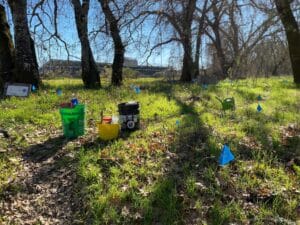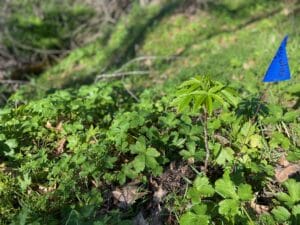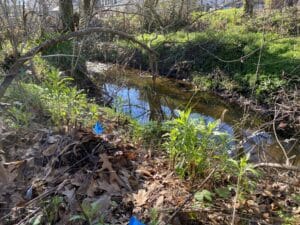This early “false spring” created beautiful working conditions for our field team who were out weeding invasive plants and nurturing small emerging native plants to give them the boost. This early sunshine is essential for new growth at the ground level before the tree canopy grows leaves and shades out the light. But a false spring can also be treacherous for delicate shoots and intrepid biologists.

Tools of the trade: buckets for weeding tools and clipboard for recording plant inventory, and a watering can for liquid fertilizer application.
The horticultural term “false spring” refers to a period of weather in late winter or early spring, when temperatures are significantly above normal and extend for a period of time. Sometimes this can have negative effects on the delicate new growth of plants, if there is a very cold spell that comes in late winter. Or it can trigger animals to come out of hibernation or migrate north too soon. However, this year, freezing temperatures still occurred at night, keeping plants accustomed to overnight frost from adjusting too quickly.
Author Glenn Keator sums this up beautifully in his book, The Life of an Oak:
“The forest understory is a changing tapestry. As winter bluster turns to bursts of warm sunshine in earliest spring, new shoots push through the dense leaf mold to reach the sun. There is a mad rush, in fact, to put on new growth and unfurl flower buds before trees have filled out their canopies. All the drama of spring is compressed into a few short weeks, with a constant change in the floral pageant…”

Leaves of three, let it be.
One plant that thrived during the early sunshine was poison oak, which was impossible for our team to avoid despite their best efforts. Good thing we stock our first aid kits with calamine lotion!
Birkin Newell, education and restoration director writes, “I use extra precautions when working in the forest floor, wearing cut-off tube socks on my forearms to prevent “glove gap” between the glove and my long-sleeved work shirt. I keep all my used work clothes in a big tub and try to keep it all isolated. Still, I get reactions on my skin and am currently trying not to scratch the itch while I type this.”

Mugwort, Artemesia douglasiana, is thriving and spreading along the banks of Starr Creek.
Restoration projects require experimentation and adaptation. We take careful inventory of which plants have thrived and which plants didn’t survive the big drought before last October’s rains. Here are the star performers for dry shade, under deciduous oaks: Basket Sedge, Carex barbarae, Sticky Monkeyflower, Mimulus auratiacus, Snowberry, Symphoricarpus albus, Douglas Iris, Iris douglasiana, Gray Rush, Juncus patens, Mugwort, Atemesia douglasiana, California Lomatium, Lomatium californicum, and California Blackberry, Rubus ursinus.
